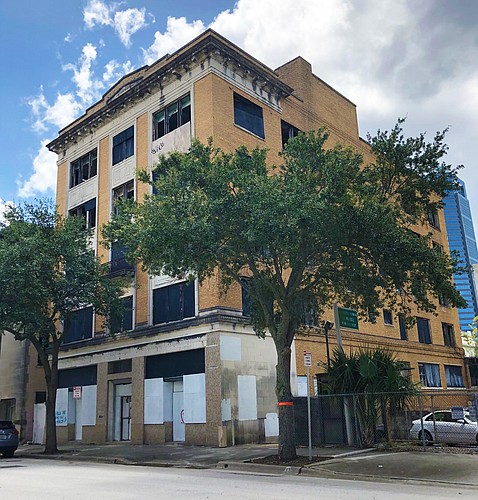
JWB Real Estate Capital added another property Downtown to its portfolio Aug. 26 by acquiring the 218 W. Church St. building for $675,000.
The five-story, 26,500-square-foot vacant office building was developed in 1924 and is landmarked as historic. JWB bought it from investor Atrium Properties 1 LLC.
“We are planning on doing a mixed-use project with commercial on the first floor and 24 residential rental units on floors two to five,” said JWB Real Estate Capital President Alex Sifakis on Aug. 28.
He said the apartments will average about 600 square feet and comprise one-bedroom and studio units.
Sifakis said the investment is undetermined.
“We are working through our plans on the project right now,” he said. “We are getting started as soon as possible.”
Sifakis said it is the last building Downtown designed by architect Henry John Klutho.
The deed was recorded Aug. 28 with the Duval County Clerk of Courts.
The building sits on 0.16 acres adjacent to the Federal Reserve Bank Building that JWB bought Aug. 3 at 424 N. Hogan St.
Next to that, Jacksonville-based JWB bought the Seminole Building, home to the Sweet Pete’s candy store, at 400 N. Hogan St. in January.
The 218 W. Church St. investment was expected. JWB bought the Federal Reserve Bank Building through 218 W. Church LLC, signaling that it intended to make the purchase.
That gives JWB three adjacent buildings on the block that were built from 1909-1924.
“We believe clustering development is important and we are going to tie the project together,” he said.
The purchase gives JWB a $4.125 million investment in those buildings – $1.75 million for the historic Federal Reserve Bank structure built in 1922; $1.7 million for the Seminole Building, built in 1909; and the $675,000 West Church Street building.
The Seminole and Federal Reserve Bank buildings are opposite City Hall.
“We are working on a project that we think will be a real asset Downtown,” Sifakis said previously.
The buildings also are close to the proposed Independent Life Building, Ambassador Hotel and Jones Bros. Furniture projects that include apartments, hotel rooms and retail space.
And they are not far from the 1.5-acre Porter House Mansion block that JWB bought Aug. 20 through 510 N Julia LLC for $2.605 million. The house was built in 1902 and renovated. JWB plans to lease it for office space and later open a restaurant in the basement.
Research talks about some of the history of 218 W. Church St.
A March 3, 2019, Call Box column by Sandy Strickland in The Florida Times-Union reported that when it opened in 1924, about 1,000 people turned out to see Jacksonville’s newest high rise – four stories with a basement.
Known as the Florida Baptist Convention Building, it was constructed 23 years after the Great Fire of 1901.
Strickland wrote that it was the first state Baptist convention to construct its own office and it was the last Downtown office building designed by Klutho.
The column said the building served as headquarters for the convention’s missions and church support programs, a retail bookstore and the Witness printing plant.
A fifth floor was added to increase rental income to pay off construction bonds.
Strickland wrote that historian Wayne Wood’s “Jacksonville’s Architectural Heritage” book describes the structure as a well-proportioned building that features “subdued classical ornamentation blended with a crisp 1920s modernism” with a small balcony on the third floor.
The convention occupied the basement, the first floor and parts of the second, and the rest was leased. In 1932 the building was renamed in honor of S.B. Rogers, the convention’s executive secretary-treasurer.
By the mid-1950s the building was occupied entirely by the convention, which sold it in 1959.
Strickland wrote it was placed on the National Register of Historic Places in 1984 and sold several times since, but was vacant for some years.
She said some redevelopment proposals for the building have not worked out.